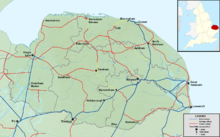
The Midland and Great Northern Joint Railway (M&GNJR) was a railway network in England, in the area connecting southern Lincolnshire, the Isle of Ely and north Norfolk. It developed from several local independent concerns and was incorporated in 1893. It was jointly owned by the Midland Railway and the Great Northern Railway, and those companies had long sponsored and operated the predecessor companies.

The Mid-Norfolk Railway (MNR) is a 17+1⁄2 miles (28.2 km) preserved standard gauge heritage railway, one of the longest in Great Britain. Preservation efforts began in 1974, but the line re-opened to passengers only in the mid-1990s as part of the "new generation" of heritage railways. The MNR owns and operates most of the former Wymondham-Fakenham branch line of the Norfolk Railway. The branch opened in 1847, was closed to passengers in stages from 1964 to 1969 as part of the Beeching cuts, and was finally fully closed to goods traffic in 1989.

Norwich railway station is the northern terminus of the Great Eastern Main Line in the East of England, serving the cathedral city of Norwich, Norfolk. It is 114 miles 77 chains (185.0 km) down the main line from London Liverpool Street, the western terminus.

The West Anglia Main Line is one of the two main lines that operate out of Liverpool Street. It runs generally north through Cheshunt, Broxbourne, Harlow, Bishop's Stortford and Audley End to Cambridge, with branches between serving Stratford, Hertford and Stansted Airport. The line runs along the boundary between Hertfordshire and Essex for much of its length.

King's Lynn railway station is the northern terminus of the Fen line in the east of England, serving the town of King's Lynn, Norfolk. It is 41 miles 47 chains (66.9 km) from Cambridge and 96 miles 75 chains (156.0 km) measured from London Liverpool Street.

The Breckland line is a secondary railway line in the east of England that links Cambridge in the west to Norwich in the east. The line runs through three counties: Cambridgeshire, Suffolk and Norfolk. It takes its name from the Breckland region of Norfolk and passes through Thetford Forest.

Cambridge railway station is the principal station serving the city of Cambridge in the east of England. It stands at the end of Station Road, 1 mile (1.6 km) south-east of the city centre. It is the northern terminus of the West Anglia Main Line, 55 miles 52 chains (89.6 km) down the line from London Liverpool Street, the southern terminus.

The Ely–Peterborough line is a railway line in England, linking East Anglia to the Midlands. It is a part of the Network Rail Strategic Route 5, SRS 05.07 and is classified as a secondary line. It is used by a variety of inter-regional and local passenger services from East Anglia to the West Midlands and North West, as well as freight and infrastructure traffic; it also links with the busy East Coast Main Line at its western end. Fenland District council put forward their Rail Development Strategy for the route in 2012, which includes infrastructure upgrades for the intermediate stations, improved frequencies for the services using it and establishing a Community Rail Partnership for the line in 2013–14.
The Eastern Region was a region of British Railways from 1948, whose operating area could be identified from the dark blue signs and colour schemes that adorned its station and other railway buildings. Together with the North Eastern Region, it covered most lines of the former London and North Eastern Railway, except in Scotland. By 1988 the Eastern Region had been divided again into the Eastern Region and the new Anglia Region, with the boundary points being between Peterborough and Whittlesea, and between Royston and Meldreth. The region ceased to be an operating unit in its own right in the 1980s and was wound up at the end of 1992.
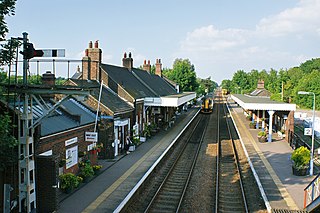
Wymondham railway station is on the Breckland Line in the East of England, serving the market town of Wymondham, Norfolk. The line runs between Cambridge in the west and Norwich in the east. It is situated between Spooner Row and Norwich, 113 miles 72 chains (183.3 km) from London Liverpool Street via Ely.
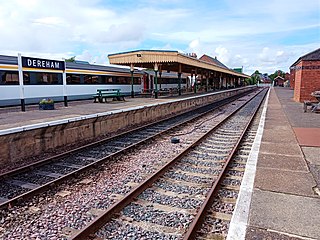
Dereham railway station is currently the northern terminus of the Mid-Norfolk Railway, a heritage line that operates services to Wymondham Abbey. It is located in the town of Dereham, in the English county of Norfolk.
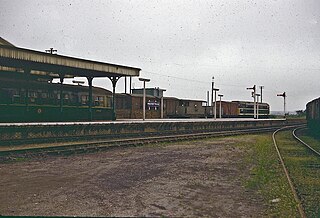
Wells-next-the-Sea railway station served the port town of Wells-next-the-Sea in North Norfolk, England. It was opened in 1857 by the Wells & Fakenham Railway, later part of the Great Eastern Railway's Wymondham to Wells branch, and became a junction in 1866 with the arrival of the West Norfolk Junction Railway. It closed in 1964.

The Norfolk Orbital Railway – as the Holt, Melton Constable and Fakenham Railway Company – is a proposed rail project in Norfolk, England, which is proposed to look at bringing a new rail connection to North and Mid Norfolk.
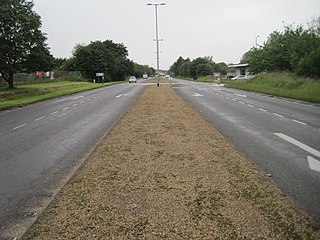
Holt railway station served the town of Holt in Norfolk, England. It was part of the Midland and Great Northern Joint Railway network, which spread over much of East Anglia, providing connections to Cromer, Norwich and Yarmouth. The station was closed in 1964 and the site is now occupied by a main road. There are proposals to rebuild the line through the town, as part of an orbital railway scheme, and possibly a new station to serve the town.
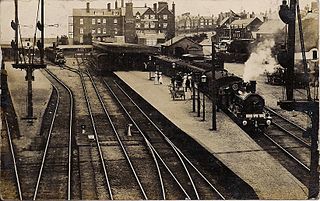
Hunstanton railway station served the seaside town of Hunstanton in Norfolk, England. Opened in 1862, the station was the northern terminus of the Lynn and Hunstanton Railway. The line was brought to public notice by John Betjeman in the British Transport Film John Betjeman Goes By Train. The station closed with the line in 1969.

The East Norfolk Railway was a pre-grouping railway company operating a standard gauge 25 mile, mostly single track, railway running between Norwich Thorpe railway station and Cromer in the English county of Norfolk. It opened in 1874, reaching Cromer three years later, and remains mostly operational. The company also operated a branch between Wroxham and County School, which closed to passengers in 1952, and had proposed a branch to Blakeney in 1878, which was never constructed.
The Lynn and Dereham Railway was a standard gauge 26+1⁄2-mile (42.6 km) single track railway running between King's Lynn and Dereham in the English county of Norfolk. The Lynn to Dereham line opened in 1846 and closed in 1968, although the section between Middleton Towers and King's Lynn remains open to freight.
The Wymondham to Wells Branch was a railway built in stages by the Norfolk Railway, Eastern Counties Railway and Wells and Fakenham Company between 1847 and 1857. The railway ran from Wymondham in the south, through Dereham and Fakenham to the coastal town of Wells-next-the-Sea; more specifically, the line ran from Wymondham South Junction, where it met the present-day Breckland Line. Passenger services along the line lasted until 1969; the railway continued to be used for freight until 1989. The southern section of the railway now forms the Mid-Norfolk Railway, with part of the northern section serving as the narrow gauge Wells and Walsingham Light Railway.

The Norfolk Railway was an early railway company that controlled a network of 94 miles around Norwich, England. It was formed in 1845 by the amalgamation of the Yarmouth and Norwich Railway opened in 1844, and the Norwich and Brandon Railway, not yet opened. These lines were built out of frustration that the Eastern Counties Railway line that was expected to connect Norwich to London failed to be completed. The Norfolk Railway also leased the Lowestoft Railway and Harbour company, and built a branch to Dereham and Fakenham, opened in 1846 and 1849 respectively.

The Lynn and Hunstanton Railway was a line in Norfolk, England that opened in 1862. The railway was a major factor in developing Hunstanton as a seaside resort and residential community. The company was allied to the West Norfolk Junction Railway which built a line connecting Heacham, south of Hunstanton, to Wells-next-the-Sea that was not a financial success. The companies amalgamated in 1874 to form the Hunstanton and West Norfolk Railway, and in 1890 the company was sold to the Great Eastern Railway.
